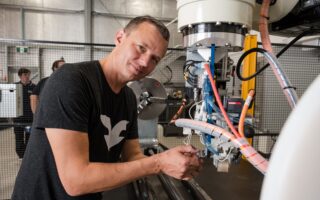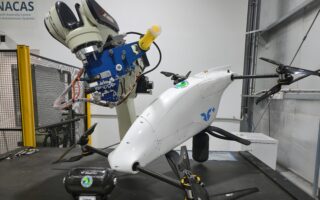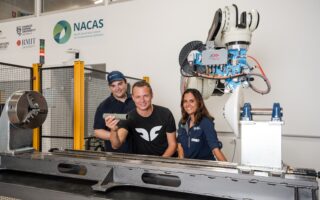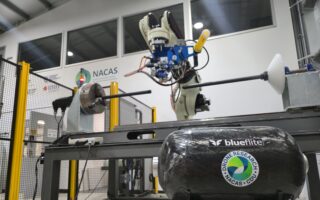Hydrogen-powered drone project hits major milestone with first prototype delivered in the NT
A project enabling delivery drones to fly further by harnessing the Northern Territory’s local strengths has surpassed its halfway milestone. Following the establishment of a Darwin site by US-headquartered blueflite, the collaborative project has achieved the successful production of a first-generation prototype pressure vessel for hydrogen storage.
The $1.79 million project has been supported by a $275,102 co-investment from the Northern Territory Government’s Advanced Manufacturing Ecosystem Fund, administered by the Advanced Manufacturing Growth Centre (AMGC). Project partners, including Charles Darwin University (CDU) are contributing both its researchers and facilities – notably, the nation’s only advanced fibre placement (AFP) industrial robot of its kind.
By enabling precise alignment and distribution of fibres within purpose-designed vessels, CDU’s specialised equipment and expertise are helping to deliver lighter, stronger, safer and more economical hydrogen storage solutions – a critical step in powering drones for long-range logistics missions.
Frank Noppel, co-founder and CEO of blueflite, believes hydrogen fuel cell power and the new storage solution will enable a three- to five-fold improvement in range versus lithium-ion batteries.
“This opens up expanded use cases in logistics, healthcare, and industrial applications, especially in remote, rural, and offshore regions,” said Noppel, whose background includes an aerospace engineering PhD and serial entrepreneurship.
“The solution also has dual-use potential for both civilian and government sectors.” said Noppel.
Blueflite’s milestone builds on CDU’s growing commitment to drone innovation, highlighted by the launch of the North Australia Centre for Autonomous Systems (NACAS) and its Airspace Integration Research Facility (AIR-F) – the only purpose-built UAV flight test facility in northern Australia.
The project also involves CDU’s Energy Resource Institute, which is trialing remote hydrogen generation and refueling the new tanks. Blueflite’s drones are being equipped with the storage vessels and tested at the Darwin Test Range – a focus on long-range capability that aligns perfectly with the Territory’s vast geography, local expertise and facilities. With a sparsely populated environment and the challenges of speed and cost of delivery, drones offer a natural solution for the region.
“The Northern Territory plays a pivotal role as an innovation testbed, and we are happy to align with its commitment to sovereign manufacturing, advanced R&D, and the development of clean aerospace and mobility solutions,” added Noppel.
The tanks will be made available to an international UAV market with an appetite for the improved range that hydrogen can deliver.
According to market research from Fact.MR, the market for long-range drones is expected to grow 18.3 per cent a year to $US 53 billion in 2035.
AMGC’s Northern Territory Director, Charmaine Phillips said: “It’s a big win not just for the NT but the nation to have a company like blueflite set up here. Their progress on this project has exciting implications, as they look to commercialise high-quality storage tanks, address a real market pull, and build up a network of local partners.”
Administered by the Advanced Manufacturing Growth Centre (AMGC), blueflite is one of 13 businesses to receive co-investment through the AMEF, which was launched in 2021. Across all projects to date, the AMEF has spurred manufacturing activity, which is expected to create over 230 new jobs and generate over $121 million for the Territory’s economy in its first five years.




